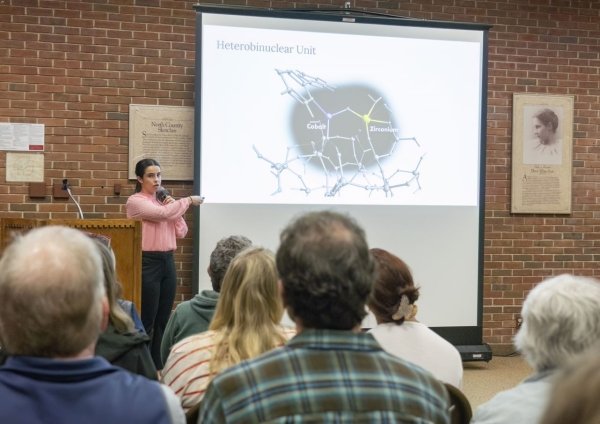
Festival of Science, Scholarship & Creativity 2023
At St. Lawrence University Festival of Science, Scholarship and Creativity on April 28, 2023, Chemistry students doing research in the Chemistry Department presented their results.

Presenter: Annie Knapp, Faculty Sponsors: Adam Hill and Catherine Jahncke, Department Chemistry
“Nonlinear Spectroscopy of Heterobinuclear Units”
Abstract: Heterobinuclear unit light absorbers consisting of chemically dissimilar transition metals can serve as light absorbers for nanoscale artificial photosystems. TiOCo and ZrOCo units on silica nanoparticles were coupled with 2,2’-bipyridine (bipy) as a luminescent electron acceptor, with TiOCo observed as a negative control. The synthesis steps were confirmed using FT-IR and the geometries of the heterobinuclear unit-bipy diads were modeled using DFT. The particles were pressed into pellets and then placed into a home-built 3D printed gas cell. Time-correlated single photon counting (TCSPC) and time-resolved emission spectroscopy (TRES) data were collected under argon and oxygen atmospheres to measure the relaxation of the excited state. The quenching of emission in the presence of oxygen supports that the long-lived excited state of the ZrOCo-bipy system is due to a change in spin state.
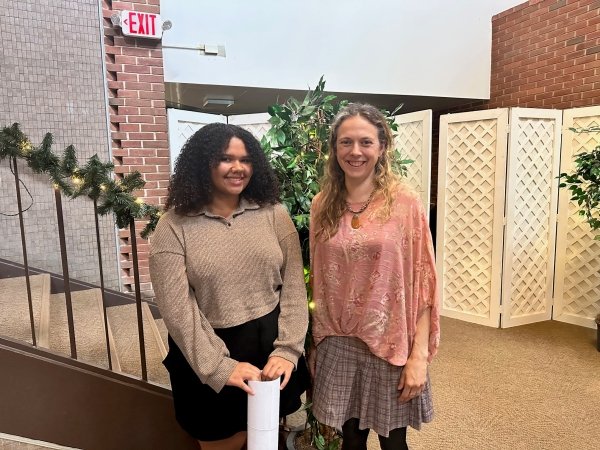
Presenter: Chyanne Turner, Faculty Sponsor: Samantha Glazier, Department Chemistry
“An Investigation of fluorescent MIP-modified amino-carbon dots for selective TNT detection”
Abstract: In analytical studies, fluorescent detectors have shown to be useful for determining the concentrations of analytes, both in controlled lab samples as well as in the environment. For these reasons, researchers have developed fluorescent compounds to be quenched by harmful and toxic compounds such as trinitrotoluene (TNT), which can then be used to determine TNT concentration. While compounds such as amino-carbon dots have already been developed that can be used to detect TNT, modifications have been performed on these compounds to make the detection of TNT selective as well, as TNT has many analogs which can also quench fluorescent compounds, making signal differentiation challenging. Amino-carbon dots have been established to be sufficient fluorescent compounds for TNT detection and concentration determination. In recent studies, these compounds have been modified for selective TNT detection with molecularly imprinted polymers (MIPs), which are polymers that are synthesized around a template molecule and can selectively adsorb various compounds. For our investigation, we have replicated the synthesis of MIP-modified amino-carbon dots via a hydrothermal method and have developed the MIP using trinitrophenol (TNP) as a template molecule. Preliminary data has demonstrated the efficacy of this method for selective TNT detection and further investigations will explore various experimental modifications to improve the detection method, which include using alternative carbon sources such as petroleum coke for the carbon dot synthesis, as well as varying the heating time for the carbon dot synthesis. The results reported in this investigation will broaden the scope of our understanding of selective fluorescent detection devices, and future research may focus on developing better methods for selective fluorescence detection via MIP-modified carbon dots.
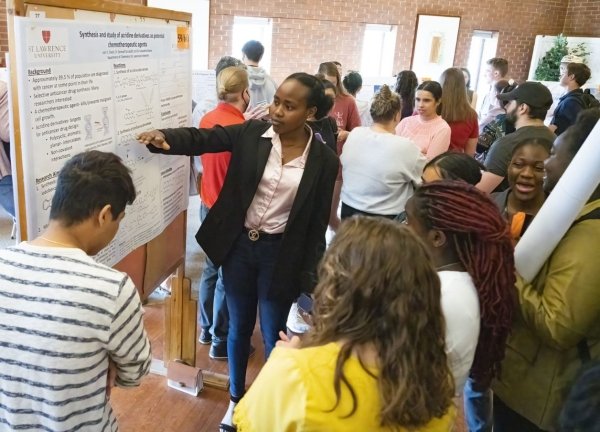
Presenter: Leah Biwot, Faculty Sponsors: Samuel Tartakoff and Samantha Glazier, Department Chemistry
“Synthesis and study of acridine derivatives as potential chemotherapeutic agents”
Abstract: Proflavine, a mutagenic acridine dye which is a common candidate for chemotherapeutic agents’ studies has been of great interest to many researchers due to its wide range of applications in industrial, therapeutic, and chemical sectors. This research focuses on synthesizing proflavine derivatives and other acridine derivatives with the aim of studying their intercalation properties as a basis for DNA-drug interaction of cancerous cells. Proflavine derivatives were successfully synthesized through acylation reaction with proflavine as the starting material. The challenge from this reaction was that the synthesized compounds are barely soluble in water, which is a challenge when testing them with DNA. This research also ventured into synthesis of acridine derivatives from simple compounds such as o-iodobenzoic acid, aniline etc. to widen the number of compounds for intercalation studies. The reactions mechanisms involved were Ullmann condensation reactions, cyclodehydration of carbonyl-containing compounds, and chlorination of the acridone. I used polyphosophoric acid for cyclodehydration, and thionyl chloride for chlorination. For future reactions, I will use phosphorous oxychloride which does both cyclodehydration and chlorination in the same step. I successfully synthesized 9-chloroacridine and several acridones with different functional groups coming off the acridine core.
Presenter: Leana Dickhens, Faculty Sponsor: Samuel Tartakoff, Department Chemistry
“Improving the Wagner-Jauregg Production & Isolation of the “ene” Product”
Abstract: Opioid compounds, such as morphine, are used as painkillers for after surgery and chronic pain, although these opioids can be very addictive. Scientist have manipulated the structure of morphine forming new pain relievers but have yet to find a non-addictive molecule. The goal of this project is to develop a more efficient Wagner-Jauregg reaction, which may be used to form a less addictive and equally effective analogue of morphine. After much trial and error, new reactants and solvents that speed up the Wagner-Jauregg reaction was discovered. Additionally, new approaches to forming a morphine analogue have been discussed for future work.
Presenter: Scott Roberts, Faculty Sponsor: Nadia Marano, Department Chemistry
“Teaching Chemistry”
Abstract: Chemistry is one of the more difficult topics for high school students. As I plan to become a chemistry teacher after my time at SLU, this is the focus of my SYE project. My goal was to research teaching techniques and develop materials to promote student engagement, understanding and enjoyment in the learning. In addition, I needed to research New York State standards as teachers in the state need to incorporate these to prepare their students for the Regents exams held annually. Shadowing and interviewing experienced teachers allowed me to gain a sense of direction into what course material to cover and how best to create a student driven class. The ideas I was most interested in pursuing were using a progressive style of teaching, adapting the course day by day to meet the students’ interests, and the use of analogies. I chose several chemistry topics to develop worksheets, laboratory exercises, and lesson plans: the periodic table of elements, concentration, dilution, density, equilibrium, and redox reactions. I incorporated aspects from the standards, literature I studied, and the classrooms I shadowed to make the lessons more student-driven and included diverse ways to get a point across. With this, I hope to create a classroom that encases everything mentioned to better the students’ education.
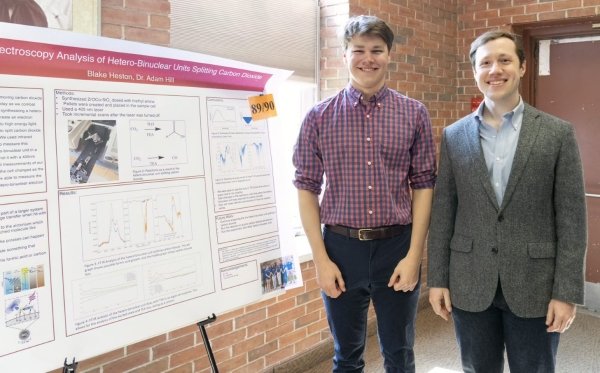
Presenter: Blake Heston, Faculty Sponsor: Adam Hill, Department Chemistry
“Infrared Spectroscopy Anaylsis of Hetero-Binuclear Units Splitting Carbon Dioxide”
Abstract: Creating efficient green processes for removing carbon dioxide from the atmosphere is very important today as we combat climate change. My research focused of synthesizing a hetero-binuclear unit (ZrOCo-SiO2) which can create an electron transfer between metals when exposed to high energy light. This electron transfer can then be used to split carbon dioxide into carbon monoxide and oxygen gas. We used infrared spectroscopy to analyze this reaction. To measure this reaction, we placed a pellet of the hetero-binuclear unit in a cell filled with carbon dioxide gas and shot it with a 405nm laser. At the same time, we took infrared measurements of our sample to analyze how the contents of the cell changed as the reaction took place. As a result, we were able to measure the splitting of carbon dioxide due to the hetero-binuclear electron transfer.
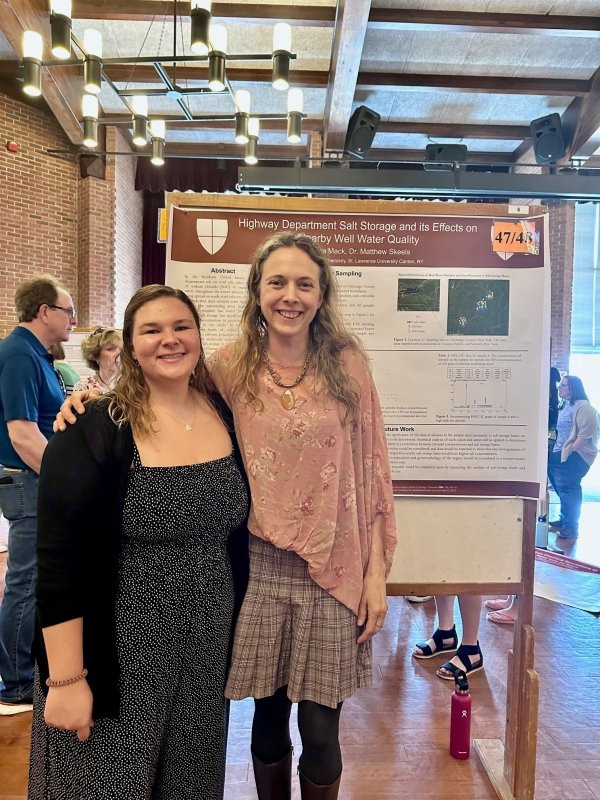
Presenter: Jenna Mack, Faculty Sponsor: Matthew Skeels, Department Chemistry
“Highway Department Salt Storage and its Effects on nearby Well Water Quality”
Abstract: In the Northern United States, highway departments rely on road salt, often composed of sodium chloride (NaCl) to maintain road safety throughout the winter seasons. When not being spread on roads, road salts are often stored in sheds that meet minimal state regulations to protect the surrounding areas from leeching. Previous research has noted instances that outdoor salt storage has significantly increased sodium concentrations in groundwater in close proximity to the sheds1. In this study, the groundwater levels of sodium, as well as magnesium, calcium, potassium, and chloride are going to be analytically evaluated to assess the effects of salt storage in relation to salt storage proximity in Chenango County, NY. Forty-two well water samples within two miles of 4 different storage sheds were collected and flame atomic absorption (FAAS) and emission (FAES) was used to determine the concentrations of each metal in every sample. High performance liquid ion chromatography (HPLC-IC) was used to determine the concentration of the anions, primarily chloride, in each water sample. Statistical methods will be employed to evaluate the likelihood of groundwater contamination by salt storage. The predicted results are that higher concentrations of each element tested will be significantly higher in water samples collected closer to the storage sheds.
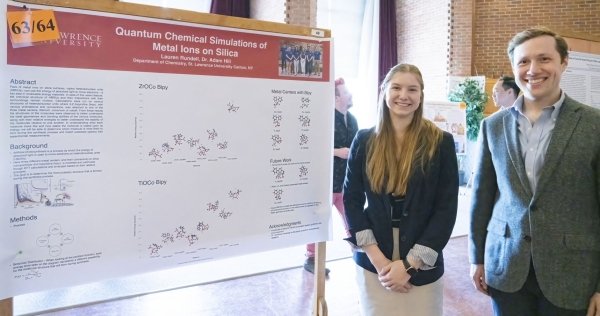
Presenter: Lauren Rundell, Faculty Sponsor: Adam Hill, Department Chemistry
“Quantum Chemical Simulations of Ions on Silica”
Abstract: Pairs of metal ions on silica surfaces, called heterobinuclear units (HBNUs), can use the energy of absorbed light to move electrons – a key step in renewable energy materials. In spite of this useful feature, the chemical structure of HBNUs and their interactions with their surroundings remain unclear. Calculations were run on various structures of heterobinuclear units where 2,2’-bipyridine (bipy), with various orientations and connections, was attached to one of the three metal centers, titanium, zirconium or cobalt. From these results the structures of the molecules were observed to better understand the ideal geometries and bonding abilities of the various molecules, along with their relative energies to better understand the stability of the molecules relative to one another. In understanding what each molecule looks like and how stable the molecule is based upon its energy; we will be able to determine which molecule is most likely to form during the synthesis process and match predicted spectra with experimental measurements.
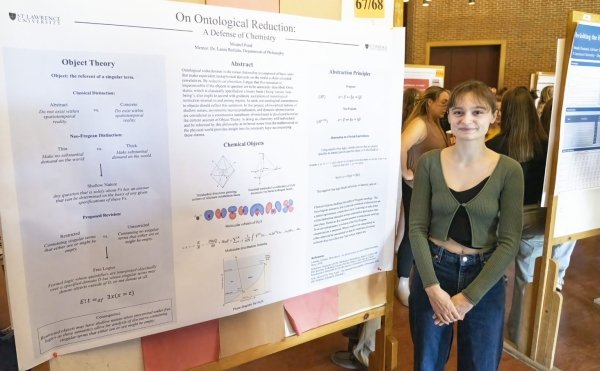
Presenter: Mirabel Pond, Faculty Sponsor: Laura Rediehs, Department Philosophy
“On Ontological Reduction: A Defense of Chemistry”
Abstract: Ontological reductionism is the notion that reality is composed of basic units that make equivalent metaphysical demands on the world as their extended correlatives. By reductio ad absurdum, I argue that this reduction is impermissible if the objects in question are to be accurately described. Ontic status, which is classically specified on a binary basis (‘being’ versus ‘non-being’), also ought to accord with gradatory ascriptions of mereological restriction internal to and among objects. As such, our ontological commitments to objects should reflect this sentiment. In this project, philosophical notions of shallow nature, asymmetric reconceptualization, and dynamic abstractionism are considered as a constructive metatheory of entailment is developed to revise the current account of Object Theory. In doing so, chemistry will both inform and be informed by this philosophy as its broad scope from the mathematical to the physical world provides insight into the necessary logic accompanying these claims.
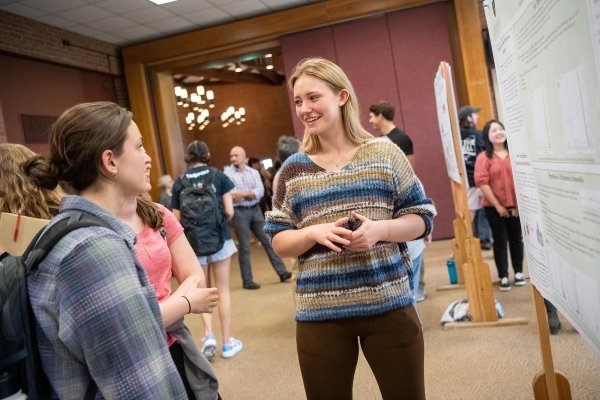
Presenter: Olivia Melvin, Faculty Sponsor: Samuel Tartakoff, Department Chemistry
“GC-MS Composition Analysis and Imitation of a Luxury Brand Fragrance”
Abstract: Because exact chemical compositions cannot be patented, imitations of high-end fragrances can be produced with the use of basic analytical equipment easily and legally. Through reverse engineering, companies can identify components of an expensive perfume or cologne and synthesize a product with a similar scent in order to market it as a ‘dupe’ and make a profit. However, these mimics are often not as long-lasting and can have decreased detectability in our olfactory receptors. Here, identification and quantification of chemical components in Black Opium Eau de Parfum by Yves Saint Laurent was approached through the use of gas chromatography-mass spectrometry (GC-MS). Select components from the original fragrance were combined with chemicals of similar scent profiles with the objective of imitating Black Opium. The ability to create mimics with cheaper, simpler, or environmentally-friendlier lists of ingredients without compromising the quality of the scent would expand opportunities in the industry of imitation fragrance production. Quality of these imitations was compared to the target fragrance through a series of evaluations of volatility and scent similarity.

Presenter: Liberty Hager, Faculty Sponsor: Karin Heckman, Department: Biology
“Characterization of Current Dental Hygiene Habits and Beverage Consumption in St. Lawrence Students”
Abstract: Increasing evidence suggests that oral health impacts overall health, with periodontal disease linked to systemic health problems like diabetes and Alzheimer's disease. While dental health is important for all ages, the transition into adulthood is a critical life stage with increased independence, leading to shifts in hygiene routines and beverage consumption. This study investigated current dental hygiene habits, beverage consumption, oral health knowledge, and access among St. Lawrence University students. An online survey addressing these dental factors yielded 101 participants, composed of 82% female-identifying students and 62.6% science majors. Regarding dental hygiene habits, 78% of students brushed their teeth twice daily, but only 30% flossed at least once daily. Participant gender and increased frequency of brushing and flossing since college were strongly correlated (p = 0.002), as were flossing frequency and student major (p = 0.000). Science majors visited the dentist or another dental professional at least once a year more frequently than other majors (p = 0.008), and the frequency of dental visits was strongly associated with dental insurance coverage (p = 0.000). Since college, coffee/tea was the largest increased consumed beverage, and milk was the most decreased beverage consumed. While there was no significant difference in beverage consumption, science majors were found to have better awareness of the impact oral care and beverage intake have on oral and overall health. This characterization exposes the need for further education across all majors on the impact of oral hygiene on both dental and overall health amongst St. Lawrence University students.
